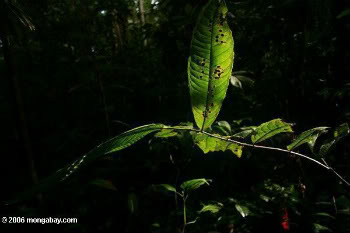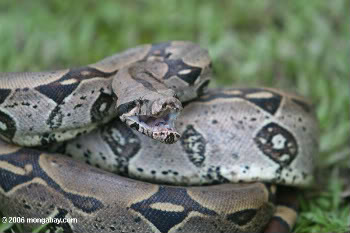Fifty eight million years ago the tropical rainforests of South America shared many similarities with today’s Neotropical forests, according to research published in the Proceedings of the National Academy of Sciences. Looking at over 2,000 fossils in Colombia from one of the world’s largest open pit coal mines, scientists were able to recreate for the first time the structure of a long vanished rainforest. One inhabited by a titanic snake, giant turtles, and crocodile-like reptiles.
Despite large changes in the climate and geology since—including a cooling in the tropics—scientists found that many flora species dominating the landscape 58 million years ago, known as the Paleocene, still dominate today, including legumes, palms, avocado, and banana. Their discoveries could have important implications for researchers working to predict how the tropics will react to climate change. Many biologists have feared that a warmer earth will devastate rainforests assuming the flora will simply be unable to withstand hotter temperatures. This study may bring everyone back to the drawing board.
 Leaf in the tropical rainforests of Colombia. Photo by: Rhett A. Butler. |
“Neotropical rainforests have an almost nonexistent fossil record,” said study co-author Fabiany Herrera, a graduate student at the Florida Museum of Natural History. “These specimens allow us to actually test hypotheses about their origins for the first time ever.”
The fact that the scientists were able to examine fossils made a big difference. Researchers have had to depend on pollen analysis for information about past tropical forests, but pollen only allows identification of species to the family level, while the fossils revealed lineage all the way down to the plant’s genus by examining the structure of preserved leafs. Moreover, fossils provide important information about insect types, climate, and forest structure.
Studying the many and varied fossils, researchers found that the Paleocene in Colombia was warmer and wetter than today with an estimated annual temperature of 86 degrees Fahrenheit and 126 inches of rainfall, whereas the average temperature of today’s Colombian rainforest is 81 degrees Fahrenheit.
“It is also intriguing that while the Cerrejón rainforest shows many of the characteristics of modern equivalents, plant diversity is lower,” Herrera said. Statistical analysis found that the diversity in the ancient tropical forests was 60 to 80 percent less than diversity today. Two different hypotheses have been put forward to explain this: one is that the period represents the epoch in which tropical forest diversification was just beginning; the other is that the forest ecosystem was in the midst of species-recovery after the extinction event that wiped out the dinosaurs and many others.
 A boa constrictor in Colombia–an ancestor of Titanoboa. Photo by: Rhett A. Butler. |
The open pit coal mine in the Cerrejon Formation has yielded more than plant fossils. Last year, researchers announced the discovery of the largest snake ever from the same pit. Named the Titanoboa, the snake made headlines worldwide and boggled the imagination of armchair paleontologists: longer than a city bus, the massive serpent is though to have replaced dinosaurs as the region’s resident super-predator.
“Like Titanoboa, which is clearly related to living boas and anacondas, the ancient forest of northern Colombia had similar families of plants as we see today in that ecosystem. The foundations of the Neotropical rainforests were there 58 million years ago,” said Florida Museum vertebrate paleontologist Jonathan Bloch, who described Titanoboa but was not part of the rainforest study.
Related articles
Monstrous prehistoric snake provides glimpse of warmer tropical forests
(02/04/2009) On Wednesday scientists announced the discovery of the world’s largest snake, a prehistoric beast which preyed on giant turtles and crocodile-like reptiles in South America after the demise of the dinosaurs. As amazing as the discovery is, its greatest importance may be the clues it provides conservationists about the future of tropical forests under various global warming scenarios.
World’s largest snake discovered: prehistoric serpent was twice the size of an anaconda

(02/04/2009) Paleontologists have recently uncovered the world’s largest snake announces a paper in Nature. Measuring an astonishing 42 to 45 feet, the Titanoboa cerrejonensis makes the anaconda look diminutive. In fact the prehistoric serpent even makes once-ridiculous horror movie snakes appear conservative. “Truly enormous snakes really spark people’s imagination, but reality has exceeded the fantasies of Hollywood,” said Jonathan Bloch, one of the leaders of the party that discovered the prehistoric serpent. “The snake that tried to eat Jennifer Lopez in the movie Anaconda is not as big as the one we found.”